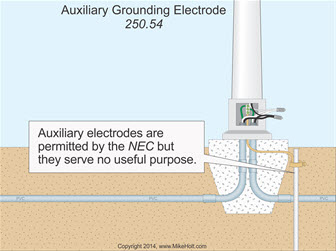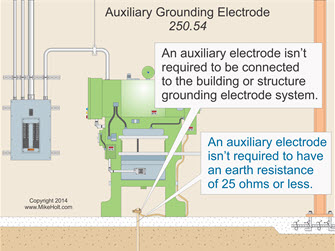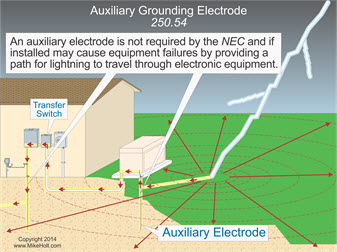|
The NEC® 2014
Section 250.54 Auxiliary Grounding Electrodes
We’re excited to bring you an extract from Mike Holt’s Illustrated Guide to NEC® Requirements for Grounding vs. Bonding to give you an introduction to the book and DVDs. As part of our ongoing effort to provide free resources to help the industry, we will be sending out a series of newsletters which will include graphics and text taken directly from a Mike Holt textbook and a video clip from the DVD program.

Watch the Video Clip!
To get the most out of this instruction, watch the video clip as you review this content. Click here or on the image to the right [duration 0:06:20]. Mike and the DVD team weigh in on the rule and discuss the practical impact of its everyday application.
Section 250.54 - Auxiliary Grounding Electrodes |
Auxiliary electrodes are permitted, but they have no requirements since they serve no useful purpose related to electrical safety addressed by the NEC. Figure 250–121

Figure 250-121
If an auxiliary electrode is installed, it’s not required to be bonded to the building grounding electrode system, required to have the grounding conductor sized to 250.66, or comply with the 25-ohm requirement of 250.53(A)(2) Ex. Figure 250–122

Figure 250-122
CAUTION: An auxiliary electrode typically serves no useful purpose, and in some cases it may actually cause equipment failures by providing a path for lightning to travel through electronic equipment. Figure 250–123

Figure 250-123
DANGER: Because the contact resistance of an electrode to the earth is so great, very little fault current returns to the power supply if the earth is the only fault current return path. Result—the circuit overcurrent device won’t open and clear the ground fault, and all metal parts associated with the electrical installation, metal piping, and structural building steel will become and remain energized.
This Article is extracted from Mike Holt’s Understanding NEC® Requirements for Grounding vs. Bonding, based on the 2014 NEC®. To order your copy of the full program, click on the image below or visit www.MikeHolt.com/14grounding and save 20% when you use discount code NL14GvB.

|



